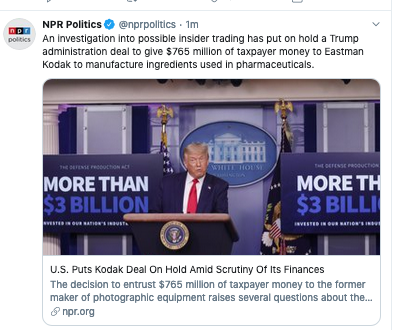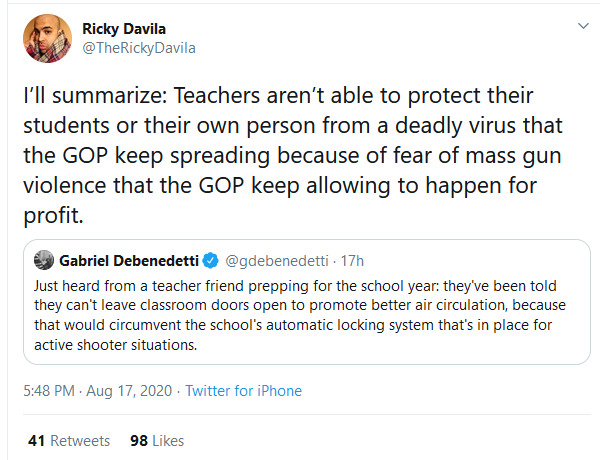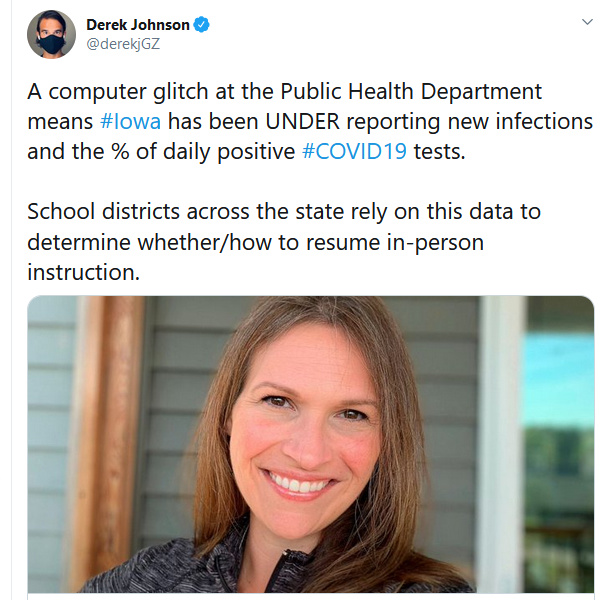Deep dive into the history of Republicans v Dems belief system on science-based developments on Covid-19 - ie vaccines, Hydroxychloroquine and potential cures or existance of Covid-19.
How did this happen? In 1973, Republicans trusted science more than religion, while Democrats trusted religion more than science. The reverse now holds true. In the meantime, working-class whites left the Democratic Party, which has increasingly taken on the outlook of the professional class with its trust in institutions and empiricism. The influx of working-class whites (especially religiously observant ones) has pushed Republicans toward increasingly paranoid varieties of populism.
This is the conventional history of right-wing populism — that it was a postwar backlash against the New Deal and the Republican Party’s inability or unwillingness to roll it back. The movement believed the government had been subverted, perhaps consciously, by conspirators seeking to impose some form of socialism, communism, or world government. Its “paranoid style,” so described by historian Richard Hofstadter, became warped with anti-intellectualism, reflecting a “conflict between businessmen of certain types and the New Deal bureaucracy, which has spilled over into a resentment of intellectuals and experts.” Its followers seemed prone to “a disorder in relation to authority, characterized by an inability to find other modes for human relationship than those of more or less complete domination or submission.” Perhaps this sounds like someone you’ve heard of.
But for all the virulence of conservative paranoia in American life, without the sanction of a major party exploiting and profiting from paranoia, and thereby encouraging its growth, the worldview remained relatively fringe. Some of the far right’s more colorful adherents, especially the 100,000 reactionaries who joined the John Birch Society, suspected the (then-novel, now-uncontroversial) practice of adding small amounts of fluoride to water supplies to improve dental health was, in fact, a communist plot intended to weaken the populace. Still, the far right lacked power. Republican leaders held Joe McCarthy at arm’s length; Goldwater captured the nomination but went down in a landslide defeat. In the era of Sputnik, science was hardly a countercultural institution. “In the early Cold War period, science was associated with the military,” says sociologist Timothy O’Brien who, along with Shiri Noy, has studied the transformation. “When people thought about scientists, they thought about the Manhattan Project.” The scientist was calculating, cold, heartless, an authority figure against whom the caring, feeling liberal might rebel. Radicals in the ’60s often directed their protests against the scientists or laboratories that worked with the Pentagon.
But this began to change in the 1960s, along with everything else in American political and cultural life. New issues arose that tended to pit scientists against conservatives. Goldwater’s insouciant attitude toward the prospect of nuclear war with the Soviets provoked scientists to explain the impossibility of surviving atomic fallout and the formation of Scientists and Engineers for Johnson-Humphrey. New research by Rachel Carson about pollution and by Ralph Nader on the dangers of cars and other consumer products made science the linchpin of a vast new regulatory state. Business owners quickly grasped that stopping the advance of big government meant blunting the cultural and political authority of scientists. Expertise came to look like tyranny — or at least it was sold that way.
…
The Republican Party’s turn against science was slow and jagged, as most party-identity changes tend to be. The Environmental Protection Agency had been created under Richard Nixon, and its former administrator, Russell Train, once recalled President Gerald Ford promising to support whatever auto-emissions guidelines his staff deemed necessary. “I want you to be totally comfortable in the fact that no effort whatsoever will be made to try to change your position in any way,” said Ford — a pledge that would be unimaginable for a contemporary Republican president to make. Not until Ronald Reagan did Republican presidents begin letting business interests overrule experts, as when his EPA used a “hit list” of scientists flagged by industry as hostile. And even Reagan toggled between giving business a free hand and listening to his advisers (as he did when he signed a landmark 1987 agreement to phase out substances that were depleting the ozone layer and a plan the next year to curtail acid rain).
The party’s rightward tilt accelerated in the 1990s. “With the collapse of the Soviet Union, Cold Warriors looked for another great threat,” wrote science historians Naomi Oreskes and Erik Conway. “They found it in environmentalism,” viewing climate change as a pretext to impose government control over the whole economy. Since the 1990s was also the decade in which scientific consensus solidified that greenhouse-gas emissions were permanently increasing temperatures, the political stakes of environmentalism soared.
…
One of the hardened realities of the modern red-blue map is that scientists have assumed a place on the blue team in the minds of both sides. A Pew survey this spring confirmed it again. About three-quarters of Democrats, but only 43 percent of Republicans, agree that scientists should take an active role in science-policy debates. Three-fifths of Democrats, but only one-third of Republicans, believe scientific experts are usually better than others at making policy decisions about scientific issues. A pile of research has found that conservatives are more distrustful than liberals of scientific forms of knowledge and are prone to believe conspiracy theories about scientists. And liberals do dominate the academy and the world of scientific research, alienated by the growing strain of know-nothing-ism in the other party.
The divide is not perfectly clean. One can still find varieties of anti-scientific thinking on the left. Anti-vaccine activists straddle the ideological divide, and distrust of GMOs, which scientists have found to be safe, persists on the grassroots left. But as science writer Arthur Allen has documented, the Democratic Party at the political level has almost uniformly spurned the anti-vaxx movement, while Republican officials in state legislatures have enlisted in its cause.
…
One Republican who paid close attention to the rise in distrust of science among the party’s base was Donald Trump, to whom the language and concepts of anti-scientific thought have come naturally. He has always arrived at his beliefs by intuition, rumor, and anecdote rather than any respect for evidence and study.
…
Later, Trump fixated on a new medical crisis: The Ebola pandemic, he warned everyone who would listen, posed a terrifying threat to Americans. Trump decried the hapless government response and demanded a complete halt of all travel to and from West Africa. During one of his public appearances, an interviewer played a clip of the director of the National Institute of Allergy and Infectious Diseases warning that such a restriction would worsen the pandemic. Trump shot back, “Well, I think it’s ridiculous.”
When he assumed the presidency just over two years later, Trump probably didn’t remember that the doctor whose expertise he had dismissed on live television, Anthony Fauci, still worked in the federal government.
Trump quickly made enemies of the scientific apparatus he commanded. During the campaign, he had made clear his implacable disdain for the entire field of climate science. But what was more surprising — or at least self-defeating — when he took office was the mixture of indifference and hostility with which he treated the rest of his scientific experts. The federal government has a vast infrastructure of data and science experts in the departments of Energy, Commerce, and Agriculture, as well as many environmental experts who are responsible for preventing and managing low-probability, high-impact disasters that could happen on Trump’s watch. In his 2018 book The Fifth Risk , Michael Lewis chronicles the neglect and suspicion with which Trump treated the people whose entire jobs were focused on preventing a cataclysm, the principal victim of which would be Trump’s own presidency. “Many of them are potentially catastrophic risks — the risk of a pandemic, or the risk of a nuclear accident, or the risk of a terrorist attack — one after another,” Lewis explained two years ago. It could have been anything. It turned out to be a pandemic.
…
When the coronavirus began spreading in American cities, the Republican Party turned to a trained store of experts whose judgment conservatives trusted implicitly. Unfortunately, their expertise and training lay not in epidemiology but in concocting pseudoscientific rationales to allow conservatives to disregard legitimate scientific conclusions.
The cadres who leapt forth to supply Trump and his allies with answers disproportionately came from the science-skeptic wing of the conservative-think-tank world. Steven Milloy, a climate-science skeptic who runs a think tank funded by tobacco and oil companies and who served on Trump’s environmental transition team, dismissed the virus as less deadly than the flu. Libertarian philosopher Richard Epstein, who had once insisted, “The evidence in favor of the close linkage between carbon dioxide and global warming has not been clearly established,” turned his analytical powers to projected pandemic death tolls. He estimated just 500 American deaths, an analysis that was circulated within the Trump White House before Epstein issued a correction.
It was like watching factories mobilize for war, only instead of automakers refitting their assembly lines to churn out tanks, these were professional manufacturers of scientific doubt scrambling to invent a new form of pedantry. Some skeptics took note of the connection, though they seem to have drawn the wrong conclusion. “While they are occurring on vastly different time scales, the COVID-19 panic and the climate-change panic are remarkably similar,” wrote one of the climate-skeptical Heartland Institute’s pseudo-experts.
…
Republicans goaded Trump to ramp up his attacks. “Dr. Fauci remains steadfast in his bureaucracy. Dr. Fauci’s a conformist,” announced Rush Limbaugh. “Here’s the difference between a health-professional bureaucrat-expert and Donald Trump.” This line reflects the view of science closest to Trump’s own perspective. He does not dismiss science wholesale as a field of study; he is not the medieval Church persecuting Galileo. Rather, he understands science as a kind of revelation accessible to a lucky genetic elite (naturally including himself, as evidenced by the genius MIT-professor uncle he often cites).
“I really get it,” he boasted during one visit to the CDC. “Every one of these doctors said, ‘How do you know so much about this?’ Maybe I have a natural ability.” That conviction is what gave Trump the confidence to deliver his on-camera brainstorming session, in which he suggested his science experts research the injection of light or disinfectant into the human body. If you don’t understand science as a discipline, you expect some genius will dream up a breakthrough cure. Why couldn’t Trump be that genius?
…
Hydroxychloroquine became a totem of Trumpist devotion. Trump urged the Food and Drug Administration, the National Institutes of Health, and the Centers for Medicare & Medicaid Services to import, promote, and pay for his favorite medicine. Exasperated public-health officials complained that it was “mindshare, time, and energy being soaked up by a potential wild-goose chase.” Conservative media published stories about ordinary Americans who had taken the cure and found their symptoms disappear as if by miracle.
Any negative finding proved the scientific body that had conducted it was corrupt. When asked about a Veterans Affairs study that added to the growing evidence against hydroxychloroquine’s efficacy, the president attacked the research as a “Trump-enemy statement.” When Dr. Bright revealed that Trump political allies had pressured him to promote the drug, Trump tweeted accusingly, “So the so-called HHS Whistleblower was against HYDROXYCHLOROQUINE,” as if this were all the proof he needed that his target had it coming.
…
Yet public-health officials in almost every economic-peer country managed to overcome scientific uncertainty and missteps. Both here and abroad, they are gazing with a mix of horror and confusion at the helpless, pitiful American scientific giant. One German expert told the Washington Post that Germany had used American studies to design an effective response, which the U.S. somehow couldn’t implement. American “scientists appeared to have reached an adequate assessment of the situation early on, but this didn’t translate into a political action plan,” observed another.
The limiting factor that has done the most to contort the domestic response to the coronavirus is the pathology of the American right. As of late May, only 40 percent of Republicans believed COVID-19 was deadlier than the flu, and half believed the death count was overstated. One research study found that viewers of Fox News, which echoed Trump’s early dismissal of the pandemic, were less likely than the audiences of other cable news channels to engage in social distancing or to purchase masks or sanitizing products.
There has always been some question about the depth of sincerity with which conservatives hold their professed convictions. Did they believe that the Clintons murdered witnesses to their crimes and that Barack Obama faked details of his birth? Or were these statements expressions of partisan enthusiasm not to be taken literally? The coronavirus revealed the deadly earnestness with which the Republican audience accepts the guidance of the conservative alternative-information structure. As early as this spring, tragic stories began to appear of people mourning the deaths of loved ones who had angrily rejected public-health advice as a big-government plot.
The playbook for handling a public-health crisis assumes some baseline level of rationality in the government. The administration is presumed to be working with, not against, its public-health experts; the news media to be informing the public, not actively disinforming it. The ranks of American government, academia, and the nonprofit sector are thick with experts in pandemic response, but very few of them ever trained to deal with a pandemic in Trump’s America.
Trump, of course, will pass from the scene, perhaps by January. But the political culture that produced him isn’t going anywhere. And one dilemma it may present quite soon is what happens when a vaccine arrives.
If Trump pulls out of his polling swoon and wins reelection, he will have to persuade Americans to trust the vaccines his administration has produced, even though many of them distrust either vaccines or Trump. (Of course, if Trump wins reelection, vaccine take-up will be the least of our problems.)



 and I thought I had seen it all with this President.
and I thought I had seen it all with this President.

